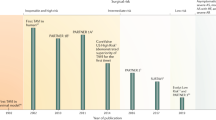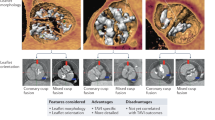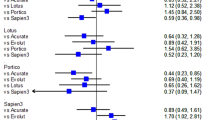Abstract
Accumulating clinical experience and technological improvements have provided the basis for transcatheter aortic valve implantation (TAVI) to emerge as a well-established means for treating patients with severe symptomatic aortic stenosis at high or prohibitive surgical risk. During this decade, TAVI has emerged as a valid alternative to surgical aortic valve replacement in patients at intermediate surgical risk, and several studies are currently being performed to evaluate the role of TAVI in patients at low surgical risk. Furthermore, promising, but preliminary, data are emerging on the efficacy of TAVI for treating patients with bicuspid aortic valve disease, as well as patients with pure aortic regurgitation. In this Perspectives article, we summarize the evolving indications for TAVI, and give our opinion on the future perspectives for this procedure.
This is a preview of subscription content, access via your institution
Access options
Access Nature and 54 other Nature Portfolio journals
Get Nature+, our best-value online-access subscription
$29.99 / 30 days
cancel any time
Subscribe to this journal
Receive 12 print issues and online access
$209.00 per year
only $17.42 per issue
Buy this article
- Purchase on Springer Link
- Instant access to full article PDF
Prices may be subject to local taxes which are calculated during checkout





Similar content being viewed by others
References
Brown, J. M. et al. Isolated aortic valve replacement in North America comprising 108,687 patients in 10 years: changes in risks, valve types, and outcomes in the Society of Thoracic Surgeons National Database. J. Thorac. Cardiovasc. Surg. 137, 82–90 (2009).
Andersen, H. R., Knudsen, L. L. & Hasenkam, J. M. Transluminal implantation of artificial heart valves. Description of a new expandable aortic valve and initial results with implantation by catheter technique in closed chest pigs. Eur. Heart J. 13, 704–708 (1992).
Pavcnik, D., Wright, K. C. & Wallace, S. Development and initial experimental evaluation of a prosthetic aortic valve for transcatheter placement. Work in progress. Radiology 183, 151–154 (1992).
Cribier, A. et al. Percutaneous transcatheter implantation of an aortic valve prosthesis for calcific aortic stenosis: first human case description. Circulation 106, 3006–3008 (2002).
Leon, M. B. et al. Transcatheter or surgical aortic-valve replacement in intermediate-risk patients. N. Engl. J. Med. 374, 1609–1620 (2016).
Reardon, M. J. et al. Surgical or transcatheter aortic-valve replacement in intermediate-risk patients. N. Engl. J. Med. 376, 1321–1331 (2017).
Yoon, S. H. et al. Outcomes in transcatheter aortic valve replacement for bicuspid versus tricuspid aortic valve stenosis. J. Am. Coll. Cardiol. 69, 2579–2589 (2017).
Sawaya, F. J. et al. Safety and efficacy of transcatheter aortic valve replacement in the treatment of pure aortic regurgitation in native and failing surgical bioprostheses — results from an International Registry Study. JACC Cardiovasc. Interv. 10, 1048–1056 (2017).
Kodali, S. et al. Early clinical and echocardiographic outcomes after SAPIEN 3 transcatheter aortic valve replacement in inoperable, high-risk and intermediate-risk patients with aortic stenosis. Eur. Heart J. 37, 2252–2262 (2016).
Wendler, O. et al. SOURCE 3 registry: design and 30-day results of the European Postapproval Registry of the latest generation of the SAPIEN 3 transcatheter heart valve. Circulation 135, 1123–1132 (2017).
Walther, T. et al. Perioperative results and complications in 15,964 transcatheter aortic valve replacements: prospective data from the GARY Registry. J. Am. Coll. Cardiol. 65, 2173–2180 (2015).
Puri, R. & Rodes-Cabau, J. Transcatheter aortic valve replacement: a revolution in evolution. JACC Cardiovasc. Interv. 9, 364–366 (2016).
Reinohl, J. et al. Effect of availability of transcatheter aortic-valve replacement on clinical practice. N. Engl. J. Med. 373, 2438–2447 (2015).
Thourani, V. H. et al. Transcatheter aortic valve replacement versus surgical valve replacement in intermediate-risk patients: a propensity score analysis. Lancet 387, 2218–2225 (2016).
Thyregod, H. G. et al. Transcatheter versus surgical aortic valve replacement in patients with severe aortic valve stenosis: 1-year results from the All-Comers NOTION Randomized Clinical Trial. J. Am. Coll. Cardiol. 65, 2184–2194 (2015).
US National Library of Medicine. ClinicalTrials.gov https://clinicaltrials.gov/ct2/show/NCT02675114 (2017).
US National Library of Medicine. ClinicalTrials.gov https://clinicaltrials.gov/ct2/show/NCT02701283 (2017).
US National Library of Medicine. ClinicalTrials.gov https://clinicaltrials.gov/ct2/show/NCT02825134 (2017).
US National Library of Medicine. ClinicalTrials.gov https://clinicaltrials.gov/ct2/show/NCT03042104 (2017).
US National Library of Medicine. ClinicalTrials.gov https://clinicaltrials.gov/ct2/show/NCT02661451 (2017).
Chamandi, C. et al. Reported versus “real” incidence of new pacemaker implantation post-transcatheter aortic valve replacement. J. Am. Coll. Cardiol. 68, 2387–2389 (2016).
De Torres-Alba, F. et al. Changes in the pacemaker rate after transition from Edwards SAPIEN XT to SAPIEN 3 transcatheter aortic valve implantation: the critical role of valve implantation height. JACC Cardiovasc. Interv. 9, 805–813 (2016).
Meredith AM, I. T. et al. Transcatheter aortic valve replacement for severe symptomatic aortic stenosis using a repositionable valve system: 30-day primary endpoint results from the REPRISE II study. J. Am. Coll. Cardiol. 64, 1339–1348 (2014).
Schofer, J. et al. Prospective multicenter evaluation of the direct flow medical transcatheter aortic valve. J. Am. Coll. Cardiol. 63, 763–768 (2014).
Silaschi, M. et al. The JUPITER registry: 1-year results of transapical aortic valve implantation using a second-generation transcatheter heart valve in patients with aortic stenosis. Eur. J. Cardiothorac. Surg. 50, 874–881 (2016).
Seiffert, M. et al. Single-centre experience with next-generation devices for transapical aortic valve implantation. Eur. J. Cardiothorac. Surg. 47, 39–45; discussion 45 (2015).
Urena, M. & Rodes-Cabau, J. Managing heart block after transcatheter aortic valve implantation: from monitoring to device selection and pacemaker indications. EuroIntervention 11 (Suppl. W), W101–W105 (2015).
Siontis, G. C. et al. Predictors of permanent pacemaker implantation in patients with severe aortic stenosis undergoing TAVR: a meta-analysis. J. Am. Coll. Cardiol. 64, 129–140 (2014).
Khatri, P. J. et al. Adverse effects associated with transcatheter aortic valve implantation: a meta-analysis of contemporary studies. Ann. Intern. Med. 158, 35–46 (2013).
Erkapic, D. et al. Risk for permanent pacemaker after transcatheter aortic valve implantation: a comprehensive analysis of the literature. J. Cardiovasc. Electrophysiol. 23, 391–397 (2012).
Elder, D. H., Lang, C. C. & Choy, A. M. Pacing-induced heart disease: understanding the pathophysiology and improving outcomes. Expert Rev. Cardiovasc. Ther. 9, 877–886 (2011).
Zhang, Z. M. et al. Mortality risk associated with bundle branch blocks and related repolarization abnormalities (from the Women's Health Initiative [WHI]). Am. J. Cardiol. 110, 1489–1495 (2012).
Zannad, F. et al. Left bundle branch block as a risk factor for progression to heart failure. Eur. J. Heart Fail. 9, 7–14 (2007).
Dvir, D. et al. First look at long-term durability of transcatheter heart valves: assessment of valve function up to 10-years after implantation. CRT Online http://www.crtonline.org/presentation-detail/first-look-at-long-term-durability-of-transcathete (2016).
Daubert, M. A. et al. Long-term valve performance of TAVR and SAVR: a report from the PARTNER I Trial. JACC Cardiovasc. Imaging 10, 15–25 (2017).
Mack, M. J. et al. 5-Year outcomes of transcatheter aortic valve replacement or surgical aortic valve replacement for high surgical risk patients with aortic stenosis (PARTNER 1): a randomised controlled trial. Lancet 385, 2477–2484 (2015).
Kapadia, S. R. et al. Protection against cerebral embolism during transcatheter aortic valve replacement. J. Am. Coll. Cardiol. 69, 367–377 (2017).
Abdul-Jawad Altisent, O., Puri, R. & Rodes-Cabau, J. Embolic protection devices during TAVI: current evidence and uncertainties. Rev. Esp. Cardiol. (Engl. Ed.) 69, 962–972 (2016).
Auffret, V. et al. Predictors of early cerebrovascular events in patients with aortic stenosis undergoing transcatheter aortic valve replacement. J. Am. Coll. Cardiol. 68, 673–684 (2016).
Mack, M. J. et al. Outcomes following transcatheter aortic valve replacement in the United States. JAMA 310, 2069–2077 (2013).
Yoon, S. H. et al. Clinical outcomes following transcatheter aortic valve replacement in asian population. JACC Cardiovasc. Interv. 9, 926–933 (2016).
Leon, M. B. et al. Transcatheter aortic-valve implantation for aortic stenosis in patients who cannot undergo surgery. N. Engl. J. Med. 363, 1597–1607 (2010).
Adams, D. H. et al. Transcatheter aortic-valve replacement with a self-expanding prosthesis. N. Engl. J. Med. 370, 1790–1798 (2014).
Jilaihawi, H. et al. A bicuspid aortic valve imaging classification for the TAVR era. JACC Cardiovasc. Imaging. 9, 1145–1158 (2016).
Mylotte, D. et al. Transcatheter aortic valve replacement in bicuspid aortic valve disease. J. Am. Coll. Cardiol. 64, 2330–2339 (2014).
Perlman, G. Y. et al. Bicuspid aortic valve stenosis: favorable early outcomes with a next-generation transcatheter heart valve in a multicenter study. JACC Cardiovasc. Interv. 9, 817–824 (2016).
Iung, B. et al. A prospective survey of patients with valvular heart disease in Europe: The Euro Heart Survey on Valvular Heart Disease. Eur. Heart J. 24, 1231–1243 (2003).
Roy, D. A. et al. Transcatheter aortic valve implantation for pure severe native aortic valve regurgitation. J. Am. Coll. Cardiol. 61, 1577–1584 (2013).
Urena, M. et al. Transcatheter aortic valve replacement to treat pure aortic regurgitation on noncalcified native valves. J. Am. Coll. Cardiol. 68, 1705–1706 (2016).
Smith, C. R. et al. Transcatheter versus surgical aortic-valve replacement in high-risk patients. N. Engl. J. Med. 364, 2187–2198 (2011).
Franzone, A. et al. Transcatheter aortic valve replacement for the treatment of pure native aortic valve regurgitation: a systematic review. JACC Cardiovasc. Interv. 9, 2308–2317 (2016).
Seiffert, M. et al. Initial German experience with transapical implantation of a second-generation transcatheter heart valve for the treatment of aortic regurgitation. JACC Cardiovasc. Interv. 7, 1168–1174 (2014).
Ribeiro, H. B. et al. Myocardial injury after transaortic versus transapical transcatheter aortic valve replacement. Ann. Thorac. Surg. 99, 2001–2009 (2015).
Ribeiro, H. B. et al. Predictors and impact of myocardial injury after transcatheter aortic valve replacement: a multicenter registry. J. Am. Coll. Cardiol. 66, 2075–2088 (2015).
US National Library of Medicine. ClinicalTrials.gov https://clinicaltrials.gov/ct2/show/NCT02818959 (2017).
US National Library of Medicine. ClinicalTrials.gov https://clinicaltrials.gov/ct2/show/NCT02732704 (2017).
Patel, J. S. et al. Access options for transcatheter aortic valve replacement in patients with unfavorable aortoiliofemoral anatomy. Curr. Cardiol. Rep. 18, 110 (2016).
Rodes-Cabau, J., Puri, R. & Chamandi, C. The caval-aortic access for performing TAVR: pushing the limits of alternative access for nontransfemoral candidates. J. Am. Coll. Cardiol. 69, 522–525 (2017).
Puri, R., Iung, B., Cohen, D. J. & Rodes-Cabau, J. TAVI or no TAVI: identifying patients unlikely to benefit from transcatheter aortic valve implantation. Eur. Heart J. 37, 2217–2225 (2016).
US National Library of Medicine. ClinicalTrials.gov https://clinicaltrials.gov/ct2/show/NCT02202434?term=NCT02202434&rank=1 (2017).
US National Library of Medicine. ClinicalTrials.gov https://clinicaltrials.gov/ct2/show/NCT02202434 (2017).
US National Library of Medicine. ClinicalTrials.gov https://clinicaltrials.gov/ct2/show/NCT02000115 (2017).
Acknowledgements
The authors thank Mélanie Côté (Québec Heart & Lung Institute, Canada) for her help in preparing the Figures. T.R.-G. receives support from a grant from the Fundacion Alfonso Martin Escudero (Madrid, Spain). J.R.-C. holds the Canadian Research Chair 'Famille Jacques Larivière' for the Development of Structural Heart Disease Interventions.
Author information
Authors and Affiliations
Contributions
R.P. and J.R.-C wrote the manuscript and provided substantial contribution to the discussion of content. All the authors researched data for the article, and reviewed and/or edited the manuscript before submission.
Corresponding author
Ethics declarations
Competing interests
C.C. has received a fellowship grant from Edwards Lifesciences. J.R.-C. has received research grants from Edwards Lifesciences and Medtronic. The other authors declare no competing interests.
Rights and permissions
About this article
Cite this article
Puri, R., Chamandi, C., Rodriguez-Gabella, T. et al. Future of transcatheter aortic valve implantation — evolving clinical indications. Nat Rev Cardiol 15, 57–65 (2018). https://doi.org/10.1038/nrcardio.2017.116
Published:
Issue Date:
DOI: https://doi.org/10.1038/nrcardio.2017.116
This article is cited by
-
Comparative Outcomes of TAVR in Mixed Aortic Valve Disease and Aortic Stenosis: A Meta-analysis
Cardiology and Therapy (2023)
-
A Biosurfactant-containing TSD Strategy to Modify Bovine Pericardial Bioprosthetic Valves for Anticalcification
Chinese Journal of Polymer Science (2023)
-
TAVR versus surgery in low-risk patients
Nature Reviews Cardiology (2019)



